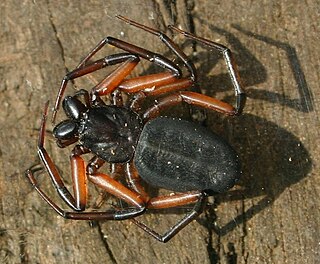
The skimmers or perchers and their relatives form the Libellulidae, the largest dragonfly family in the world. It is sometimes considered to contain the Corduliidae as the subfamily Corduliinae and the Macromiidae as the subfamily Macromiinae. Even if these are excluded, there remains a family of over 1000 species. With nearly worldwide distribution, these are almost certainly the most often seen of all dragonflies.

Corinnidae is a family of araneomorph spiders, sometimes called corinnid sac spiders. The family, like other "clubionoid" families, has a confusing taxonomic history. Once it was a part of the large catch-all taxon Clubionidae, now very much smaller. The original members of the family are apparently similar only in that they have eight eyes arranged in two rows, conical anterior spinnerets that touch and are generally wandering predators that build silken retreats, or sacs, usually on plant terminals, between leaves, under bark or under rocks.

Myrmarachne is a genus of ant-mimicking jumping spiders that was first described by W. S. MacLeay in 1839. They are commonly called ant-mimicking spiders, but they are not the only spiders that have this attribute. The name is a combination of Ancient Greek μύρμηξ, meaning "ant", and ἀράχνη, meaning "spider".

Chrysilla is a genus of jumping spiders that was first described by Tamerlan Thorell in 1887. Several species formerly placed here were transferred to Phintella, and vice versa. Females are 3 to 4 millimetres long, and males are 4 to 9 millimetres long. The genus is Persian, derived from the Greek Χρύσιλλα.

Telamonia is a genus of jumping spiders that was first described by Tamerlan Thorell in 1887. They are colorful spiders, with patterns that vary considerably between sexes and species. Two longitudinal stripes along the abdomen are common, and the carapace is often colored. They have a slender opisthosoma and long legs.

Thiania is a genus of jumping spiders that was first described by Carl Ludwig Koch in 1846.

Trochanteriidae is a family of spiders first described by Ferdinand Karsch in 1879 containing about 52 species in 6 genera. Most are endemic to Australia though Doliomalus and Trochanteria are from South America and Plator is from Asia. Platyoides species exist in southern and eastern Africa, Madagascar, and the Canary Islands with one species, P. walteri, introduced to Australia.

The Phaneropterinae, the sickle-bearing bush crickets or leaf katydids, are a subfamily of insects within the family Tettigoniidae. Nearly 2,060 species in 85 genera throughout the world are known. They are also known as false katydids or round-headed katydids.

Eristalinus fuscicornis is a species of hoverfly. It is native to sub-saharan Africa, with specimens being identified from Angola, Benin, DR Congo, Kenya, Mozambique, Nigeria, South Africa, Sudan/South Sudan, Togo, and Zimbabwe.

Chilobrachys is a genus of Asian tarantulas that was first described by Ferdinand Anton Franz Karsch in 1892. They are found in India, Myanmar, Malaysia, China, Vietnam, Thailand and Sri Lanka. They are usually medium or large-sized, and they can stridulate by using small spines present on the chelicerae.
Stasina is a genus of huntsman spiders that was first described by Eugène Louis Simon in 1877. Many former species have been transferred to Thelcticopis and Neostasina.

The Hetrodinae are a subfamily of robust bush crickets, also known as armoured katydids, corn crickets, etc. currently including five tribes.

Pamphagidae is a family of grasshoppers belonging to the superfamily Acridoidea. The species in this family can be found in Africa, Europe and Asia.

Acroaspis is a genus of South Pacific orb-weaver spiders first described by Ferdinand Karsch in 1878.

Cladonotinae is a subfamily of groundhoppers containing more than 70 genera and 260 described species. These insects are found in tropical areas world-wide.
Pagopedilum is a genus of grasshoppers in the subfamily Porthetinae, with species found in the south of Africa.













